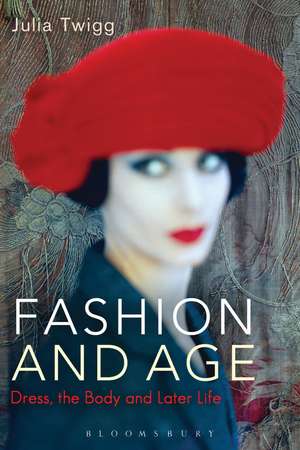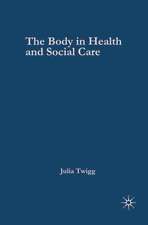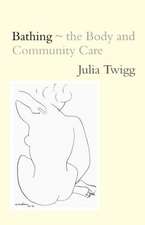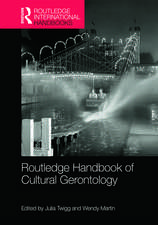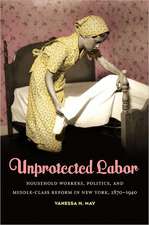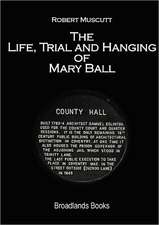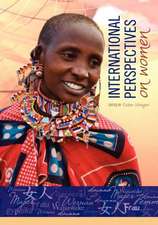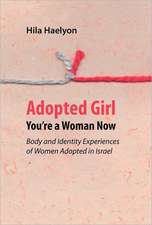Fashion and Age: Dress, the Body and Later Life
Autor Julia Twiggen Limba Engleză Hardback – 3 iul 2013
| Toate formatele și edițiile | Preț | Express |
|---|---|---|
| Paperback (1) | 177.32 lei 6-8 săpt. | |
| Bloomsbury Publishing – 3 iul 2013 | 177.32 lei 6-8 săpt. | |
| Hardback (1) | 772.58 lei 6-8 săpt. | |
| Bloomsbury Publishing – 3 iul 2013 | 772.58 lei 6-8 săpt. |
Preț: 772.58 lei
Preț vechi: 989.74 lei
-22% Nou
Puncte Express: 1159
Preț estimativ în valută:
147.83€ • 154.35$ • 122.35£
147.83€ • 154.35$ • 122.35£
Carte tipărită la comandă
Livrare economică 05-19 aprilie
Preluare comenzi: 021 569.72.76
Specificații
ISBN-13: 9781847886965
ISBN-10: 1847886965
Pagini: 184
Ilustrații: 12 bw illus
Dimensiuni: 156 x 234 x 13 mm
Greutate: 0.45 kg
Ediția:New.
Editura: Bloomsbury Publishing
Colecția Bloomsbury Academic
Locul publicării:London, United Kingdom
ISBN-10: 1847886965
Pagini: 184
Ilustrații: 12 bw illus
Dimensiuni: 156 x 234 x 13 mm
Greutate: 0.45 kg
Ediția:New.
Editura: Bloomsbury Publishing
Colecția Bloomsbury Academic
Locul publicării:London, United Kingdom
Caracteristici
A multi-disciplinary topic that will have wide appeal across subject areas
Notă biografică
Julia Twigg is Professor in the School of Social Policy, Sociology and Social Research at the University of Kent. She is co-convenor of the BSA Body, Ageing and Society, and Chair of the Advisory Group for the Smart Clothes and Wearable Technologies NDA project based at University of Wales, Newport, UK.
Cuprins
I: IntroductionII: Clothing, Fashion and the BodyIII: Ageing, Embodiment and CultureIV: The Voices of Older WomenV:Dress and the Narration of LifeVI: Magazines, the Media and Mrs ExeterVII: The High Street Responds: Designing for the Older MarketIX: ConclusionReferences
Recenzii
We're all Fabulous Fashionistas now, if the press is to be believed. The baby boomers, who wore Biba and Mary Quant, are opting for the same colourful styles as their daughters. Yet this simplistic view is about to be challenged by Julia Twigg, professor of sociology at the University of Kent and author of Fashion and Age, an academic study of dress and later life.
[A] fascinating discussion of what happens to our sense of fashion as we reach later life. As [Twigg] puts it, "age is not just peripheral to fashion but positively erosive of it". Drawing on interviews with those who wear, sell and write about fashion, Twigg addresses a range of questions about how we negotiate fashion as we get older...This book is a welcome addition to an expanding field...The author's grasp of the nuances of interpretation of fashion, dress and clothing is excellent.
I found this book absorbing and clever in its use of wide-ranging ideas and approaches ... It is clearly and articulately written, and I have no doubt that scholars from a wide range of disciplines will find it as stimulating and thought-provoking as I did
First-person narrations, testimonies and ... [interviews with] consumers, producers and publicists regarding fashion and old age give a three-dimensional perspective and a clearly added value to Twigg's study ... A valuable source of data.
An absorbing and imaginative book which opens out a new area of investigation in cultural studies and the sociology of age. Drawing upon interviews with older women and those working in the fashion industry, the research provides rich insights into the role of clothing and dress in shaping identity in later life. The book provides an exemplary balance of empirical, historical, and theoretical perspectives. This is an outstanding study deserving of a wide readership.
This innovative book provides a carefully crafted, rich and sophisticated account of the interplay between bodily and cultural aging through the lens of fashion and dress for older women. Fashion and Age explores central questions in contemporary culture, including how dress plays a significant part in the constitution of identities. By weaving empirical research with a breadth of theoretical ideas, this agenda-setting book is essential reading within ageing, gender, and consumption studies.
Age studies makes a heady, liberating move into fashion with Julia Twigg's smart and entertaining book. Focusing her research on the intersections of feminism, cheap consumables, and women's individualized development of their own look in relation to "appropriateness," Twigg can explain how it is that (in spite of fashion's cult of youth), many more women of a certain age are finally dressing without pain.
Fashion and Age is a path-breaking book on the neglected topic of how later life and clothing function in today's society. Julia Twigg shows how older women, the media and the High Street all interact to create our understanding of both ageing and dress. In doing so, Julia Twigg has produced a key text for those interested in the operation of the fashion industry as well as those seeking to understand the links between the personal narratives of ageing and the contemporary nature of embodiment. Fashion and Age provides plenty of food for thought for students and researchers alike and is a valuable addition to the cultural sociology of ageing.
[A] fascinating discussion of what happens to our sense of fashion as we reach later life. As [Twigg] puts it, "age is not just peripheral to fashion but positively erosive of it". Drawing on interviews with those who wear, sell and write about fashion, Twigg addresses a range of questions about how we negotiate fashion as we get older...This book is a welcome addition to an expanding field...The author's grasp of the nuances of interpretation of fashion, dress and clothing is excellent.
I found this book absorbing and clever in its use of wide-ranging ideas and approaches ... It is clearly and articulately written, and I have no doubt that scholars from a wide range of disciplines will find it as stimulating and thought-provoking as I did
First-person narrations, testimonies and ... [interviews with] consumers, producers and publicists regarding fashion and old age give a three-dimensional perspective and a clearly added value to Twigg's study ... A valuable source of data.
An absorbing and imaginative book which opens out a new area of investigation in cultural studies and the sociology of age. Drawing upon interviews with older women and those working in the fashion industry, the research provides rich insights into the role of clothing and dress in shaping identity in later life. The book provides an exemplary balance of empirical, historical, and theoretical perspectives. This is an outstanding study deserving of a wide readership.
This innovative book provides a carefully crafted, rich and sophisticated account of the interplay between bodily and cultural aging through the lens of fashion and dress for older women. Fashion and Age explores central questions in contemporary culture, including how dress plays a significant part in the constitution of identities. By weaving empirical research with a breadth of theoretical ideas, this agenda-setting book is essential reading within ageing, gender, and consumption studies.
Age studies makes a heady, liberating move into fashion with Julia Twigg's smart and entertaining book. Focusing her research on the intersections of feminism, cheap consumables, and women's individualized development of their own look in relation to "appropriateness," Twigg can explain how it is that (in spite of fashion's cult of youth), many more women of a certain age are finally dressing without pain.
Fashion and Age is a path-breaking book on the neglected topic of how later life and clothing function in today's society. Julia Twigg shows how older women, the media and the High Street all interact to create our understanding of both ageing and dress. In doing so, Julia Twigg has produced a key text for those interested in the operation of the fashion industry as well as those seeking to understand the links between the personal narratives of ageing and the contemporary nature of embodiment. Fashion and Age provides plenty of food for thought for students and researchers alike and is a valuable addition to the cultural sociology of ageing.
Descriere
A fascinating account of the relationship between dress and age and the first study to investigate the changing ways in which the fashion industry interacts with older generations, the book is driven by the desire to extend the remit of the study of fashion to encompass clothing as part of everyday bodily life.
